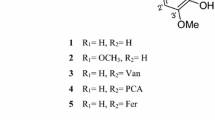Abstract
Sixteen plant-derived or synthetic coumarins with different patterns of substitution were tested for their capacity to modify A23187-induced synthesis of leukotriene B4 and thromboxane B2 via the 5-lipoxygenase and cyclooxygenase pathways of arachidonate metabolism in rat peritoneal exudate leukocytes. Five of the 16 coumarins inhibited LTB4 production: all containortho-dihydroxy substitutions (approximate IC50 values 8–100 μM). The mechanism is likely to depend upon a combination of the coumarins' iron-chelating and iron ion-reducing abilities, properties which also confer beneficial activities of these compounds as scavengers of reactive oxygen species (Payá et al., Biochem. Pharmacol.44, 205–214 (1992)). Inhibition of the cyclooxygenase pathway was only demonstrated by one compound, 5,7-dihydroxy-4-methylcoumarin, which did not inhibit 5-lipoxygenase, indicating that the cyclooxygenase inhibitory mechanism is different. Similar effects of the active coumarins were obtained using arachidonic acid as substrate for rat leukocyte eicosanoid generation, confirming that they act at the 5-lipoxygenase/cyclooxygenase level. The same profile of activity was also shown when the coumarins were tested against 5-lipoxygenase in human polymorphonuclear neutrophils. Taken together, these antioxidant and anti-eicosanoid properties of coumarins could be exploited for the design of potentially valuable non-toxic anti-inflammatory agents for treating diseases in which eicosanoid generation and the production of reactive oxygen species are involved.
Similar content being viewed by others
References
M. Payá, B. Halliwell and J. R. S. Hoult,Interactions of a series of coumarins with reactive oxygen species. Scavenging of superoxide, hypochlorous acid and hydroxyl radicals. Biochem. Pharmacol.44, 205–214 (1992).
M. Payá, B. Halliwell and J. R. S. Hoult,Peroxyl radical scavenging by a series of coumarins. Free Rad. Res. Commun.17, 293–298 (1992).
D. Egan, R. O'Kennedy, E. Moran, D. Cox, E. Prosser and R. D. Thornes,The pharmacology, metabolism, analysis and plications of coumarin and coumarin-related compounds. Drug Metab. Rev.22, 503–529 (1990).
J. R. Casley-Smith, E. Földi-Börcsök and M. Földi,The electron microscopy of the effects of treatment with coumarin (Venalot) and by thoracic duct cannulation on thermal injuries. Br J. Exp. Pathol.53, 1–5 (1973).
N. B. Piller,A comparison of the effectiveness of some anti-inflammatory drugs on thermal oedema. Br. J. Exp. Pathol.56, 554–560 (1975).
K. Sekiya, H. Okuda and S. Arichi,Selective inhibition of platelet lipoxygenase by esculetin. Biochim. Biophys. Acta713 68–72 (1982).
R. E. Lee, G. Bykadi and W. A. Ritschel,Inhibition of prostaglandin biosynthesis by coumarin, 4-hydroxycoumarin and 7-hydroxycoumarin. Arzneimittel Forsch.31, 640–642 (1981).
T. Neichi, Y. Koshihara and S. I. Murota,Inhibitory effect of esculetin on 5-lipoxygenase and leukotriene biosynthesis. Biochim. Biophys. Acta753, 130–132 (1983).
Y. Kimura, H. Okuda, S. Arichi, K. Baba and M. KozawaInhibition of the formation of 5-hydroxy-6,8,11,14-eicosatetraenoic acid from arachidonic acid in polymorphonuclear leukocytes by various coumarins. Biochim. Biophys. Acta834, 224–229 (1985).
P. A. Craven, J. Pfanstiel and F. R. De Rubertis,Role of reactive oxygen in the bile salt stimulation of colonic epithelial proliferation. J. Clin. Invest.77, 850–859 (1986).
P. Gresele, E. Ribaldi, A. M. Mezzasoma, E. Quero, M. Stasi, M. Prosdocimi, G. Goracci and G. G. Nenci,Cloricromene inhibits leukotriene formation by human polymorphonuclear leucocytes by suppressing arachidonate release from membrane phospholipids. Biochem. Pharmacol.45, 123–130 (1993).
M.-A. Moroney, M. J. Alcaraz, R. A. Forder, F. Carey and J. R. S. Hoult,Selectivity of neutrophil 5-lipoxygenase and cyclooxygenase inhibition by an anti-inflammatory flavonoid glycoside and related aglycone flavonoids. J. Pharm. Pharmacol.40, 787–792 (1988).
T. G. C. Bird, P. Bruneau, G. C. Crawley, M. P. Edwards S. J. Foster, J.-M. Girodeau, J. F. Kingston and R. M. McMillan,(Methoxyalkyl) thiazoles: A new series of potent, selective and orally active 5-lipoxygenase inhibitors displaying high enantioselectivity. J. Med. Chem.34, 2176–2186 (1991).
T. Horie, M. Tsukayama, H. Kourai, C. Yokoyama, M. Furukawa, T. Yoshimoto, S. Yamamoto, S. Watanabe-Kohno and K. Ohata,Syntheses of 5,6,7- and 5,7,8-trioxygenated 3′4′-dihydroxyflavones having alkoxy groups and their inhibitory activities against arachidonate 5-lipoxygenase. J. Med. Chem.29, 2256–2262 (1986).
T. Yoshimoto, M. Furukawa, S. Yamamoto, T. Horie and K. Watanabe-Kohno,Flavonoids: Potent inhibitors of arachidonate 5-lipoxygenase. Biochem. Biophys. Res. Commun.116, 612–618 (1983).
C. Kemal, P. Louis-Flamberg, R. Krupinski-Olsen and A. L. Shorter,Reductive inactivation of soybean lipoxygenase I by catechols: A possible mechanism for regulation of lipoxygenase activity. Biochemistry26, 7064–7072 (1987).
M. J. Nelson,Catecholate complexes of ferric soybean lipoxygenase I. Biochemistry27, 4273–4278 (1988).
M. J. Nelson, D. G. Batt, J. S. Thompson and S. W. Wright,Reduction of the active site iron by potent inhibitors of lipoxygenase. J. Biol. Chem.266, 8225–8229 (1991).
M. J. Laughton, P. J. Evans, M.-A. Moroney, J. R. S. Hoult and B. Halliwell,Inhibition of mammalian 5-lipoxygenase and cyclo-oxygenase by flavonoids and phenolic dietary additives. Relationship to antioxidant activity and to iron ion-reducing ability. Biochem. Pharmacol.42, 1673–1681 (1991).
J. Y. Channon and C. C. Leslie,A calcium-dependent mechanism for associating a soluble arachidonoyl-hydrolysing phospholipase A 2 with membrane in the macrophage cell line RAW 264.7. J. Biol. Chem.265, 5409–5413 (1990).
J. D. Clark, L.-L. Lin, R. W. Kriz, C. S. Ramesha, L. A. Sultzman, A. Y. Lin, N. Milona and J. L. Knopf,A novel arachidonic acid-selective cytosolic PLA 2 contains a Ca 2+-dependent translocation domain with homology to PKC and GAP. Cell65, 1043–1051 (1991).
J. Wijkander and R. Sundler,An 100-kDa arachidonatemobilising phospholipase A 2 in mouse spleen and the macrophage cell line J774. Purification, substrate interaction and phosphorylation by protein kinase C. Eur. J. Biochem.202, 873–880 (1991).
J. M. C. Gutteridge,Free radicals in disease processes: A compilation of cause and consequence. Free Rad. Res. Commun.19, 141–158 (1993).
I. Emerit, R. Arutyunyan, T. Sarkisian, H. Mejlumian, E. Torosian and A. G. Panossian,Oxyradical-mediated chromosome damage in patients with familial mediterranean fever. Free Rad. Biol. Med.15, 265–271 (1993).
Author information
Authors and Affiliations
Rights and permissions
About this article
Cite this article
Hoult, J.R.S., Forder, R.A., de las Heras, B. et al. Inhibitory activity of a series of coumarins on leukocyte eicosanoid generation. Agents and Actions 42, 44–49 (1994). https://doi.org/10.1007/BF02014299
Received:
Accepted:
Issue Date:
DOI: https://doi.org/10.1007/BF02014299




